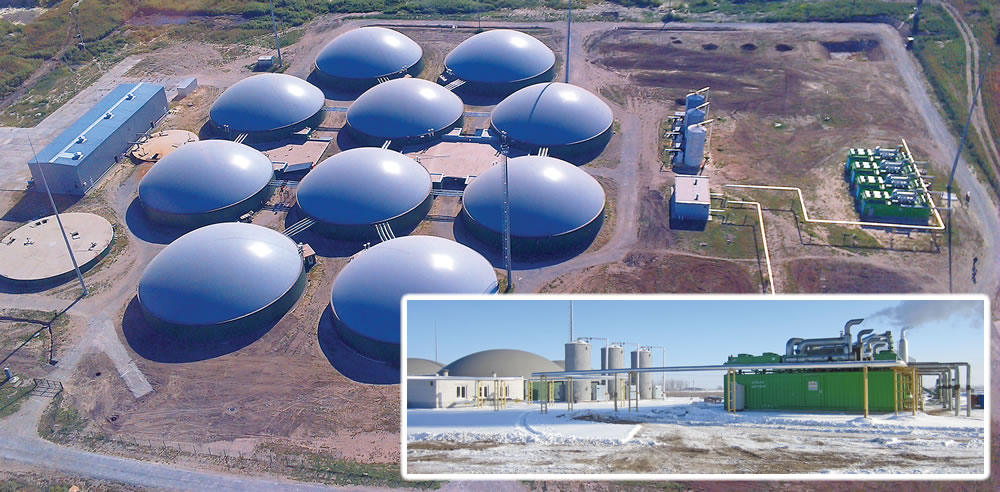LCA AND GREENHOUSE GAS BENEFITS OF RECYCLED NITROGEN —- In a study entitled “Carbon Footprint and Energy Use of Recycled Fertilizers in Arable Farming”, the authors compared energy use and greenhouse emissions using several LCA methods, calculated according to field trial crop yields, and modelled field nitrogen (N) losses. The recycled N fertilizers tested were digestate from anaerobic digestion of wastes, meat and bone meal (combined with oat hulls, chicken manure and vinasse) and ammonium sulphate from nylon product. For the mineral fertilizer, data for calcium ammonium nitrate from Ecoinvent was used. Field trials were carried out using the three recycled N fertilizers, mineral fertilizer and no fertilizer (control), using spring sown oats near Helsinki, Finland. Yields with the recycled fertilizers were not statistically significantly different from yields with the mineral fertilizer (whereas control yield was significantly lower than all fertilizer treatments), but nonetheless the somewhat lower average yields with the recycled fertilizers were used in the LCA calculation (-7% to -15%). Atmospheric and leaching N emissions from fields were estimated based on N inputs, crop yield and coefficients for organic (digestate, meal and bone meal) or mineral (mineral fertilizer, ammonium sulphate) N fertilizers. Energy use and GHG emissions were lower for the recycled N fertilizers than for mineral fertilizers, whatever the calculation method, with differences between the recycled N fertilizers varying depending on the calculation method.
PATHOGENS IN STRUVITE FROM POULTRY MANURE DIGESTATE —- Struvite precipitated in batch lab tests from poultry slurry digestate (mesophilic, 37°C) showed significant levels of foodborne pathogens, depending on precipitation pH and post-treatment: Escherichia coli, Streptococcus, Clostridium — this is the main finding of a recent study entitled “Quantitative Characterization and Effective Inactivation of Biological Hazards in Struvite Recovered From Digested Poultry Slurry”. The batch struvite precipitation tests involved 40 minutes reaction time and 30 minutes settling, at pH 9, 10 or 11. Pathogen inactivation technologies were tested on the recovered struvite: drying (35 – 55 °C), high humidity hot air impingement blanching (HHAIB, 110 – 130 °C), cold plasma (30 – 60 seconds). These technologies significantly reduced pathogens to “very low” levels, lower than natural soil levels. They did not modify the struvite crystal structure, but they did reduce metal-oxygen functional group abundance, and treatments > 55°C would lead to ammonia loss. This study confirms the need for further investigation of pathogens in recovered struvites and approaches to reduce these, including in continuous precipitation installations (rather than batch tests), as well as testing of washing and low temperature drying – storage for pathogen reduction. ESPP notes that the anaerobic digestion, depending on operating temperature and conditions, can also ensure sanitary safety of the digestate, upstream of the struvite recovery.
FERTILIZERS FROM SPENT FIRE EXTINGUISHER POWER —- This study focused on “Pelletization of Compost from Different Mixtures with the Addition of Exhausted Extinguishing Powders”. End-of-life powder from ABC fire extinguishers, containing MAP and ammonium sulphate was combined with compost and fibres to produce pellets. Fire extinguishers must be emptied and the powder renewed every three years. The powder contains 40-50% MAP* and additives for flow / anti-caking, colour or water repellence (in particular, silicones). After removal of these additives, the spent extinguisher powder was combined with dried compost and fibres, in five different combinations, each with 10% spent extinguisher powder, in a rotary 6 mm die pressing machine. Lignin in the wood chips showed to be an effective binder and pellets showed mechanical resistance (necessary for handling) and water uptake (necessary to render nutrients plant available) compatible with agricultural use. Further work is needed to assess the fertilizer value (especially crop nutrient availability) of the pellets, to test their handling and resistance in agricultural equipment (verify no dusting) and to ensure no risk of dust release to the environment or inhalation during spent extinguisher powder preparation, handling and pelletizing.




